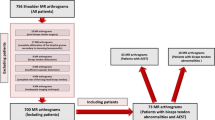Abstract
Objective
To describe the aponeurotic expansion of the supraspinatus tendon with anatomic correlations and determine its prevalence in a series of patients imaged with MRI.
Materials and methods
In the first part of this HIPAA-compliant and IRB-approved study, we retrospectively reviewed 150 consecutive MRI studies of the shoulder obtained on a 1.5-T system. The aponeurotic expansion at the level of the bicipital groove was classified as: not visualized (type 0), flat-shaped (type 1), oval-shaped and less than 50 % the size of the adjacent long head of the biceps section (type 2A), or oval-shaped and more than 50 % the size of the adjacent long head of the biceps section (type 2B). In the second part of this study, we examined both shoulders of 25 cadavers with ultrasound. When aponeurotic expansion was seen at US, a dissection was performed to characterize its origin and termination.
Results
An aponeurotic expansion of the supraspinatus located anterior and lateral to the long head of the biceps in its groove was clearly demonstrated in 49 % of the shoulders with MRI. According to our classification, its shape was type 1 in 35 %, type 2A in 10 % and type 2B in 4 %. This structure was also identified in 28 of 50 cadaveric shoulders with ultrasound and confirmed at dissection in 10 cadavers (20 shoulders). This structure originated from the most anterior and superficial aspect of the supraspinatus tendon and inserted distally on the pectoralis major tendon.
Conclusion
The aponeurotic expansion of the supraspinatus tendon can be identified with MRI or ultrasound in about half of the shoulders. It courses anteriorly and laterally to the long head of the biceps tendon, outside its synovial sheath.










Similar content being viewed by others
References
Sheah K, Bredella MA, Warner JJ, Halpern EF, Palmer WE. Transverse thickening along the articular surface of the rotator cuff consistent with the rotator cable: identification with MR arthrography and relevance in rotator cuff evaluation. AJR Am J Roentgenol. 2009;193(3):679–86.
Gheno R, Zoner CS, Buck FM, et al. Accessory head of biceps brachii muscle: anatomy, histology, and MRI in cadavers. AJR Am J Roentgenol. 2010;194(1):W80–3.
Goh CK, Peh WC. Pictorial essay: pitfalls in magnetic resonance imaging of the shoulder. Can Assoc Radiol J J Assoc Can Radiol. 2012;63(4):247–59.
Brodie CG. Note on the transverse-humeral, coraco-acromial, and coraco-humeral ligaments, &c. J Anat Physiol. 1890;24(Pt 2):247–52.
Clark JM, Harryman 2nd DT. Tendons, ligaments, and capsule of the rotator cuff. Gross and microscopic anatomy. J Bone Joint Surg Am. 1992;74(5):713–25.
Beall DP, Williamson EE, Ly JQ, et al. Association of biceps tendon tears with rotator cuff abnormalities: degree of correlation with tears of the anterior and superior portions of the rotator cuff. AJR Am J Roentgenol. 2003;180(3):633–9.
Buck FM, Grehn H, Hilbe M, Pfirrmann CW, Manzanell S, Hodler J. Degeneration of the long biceps tendon: comparison of MRI with gross anatomy and histology. AJR Am J Roentgenol. 2009;193(5):1367–75.
Morag Y, Jacobson JA, Shields G, et al. MR arthrography of rotator interval, long head of the biceps brachii, and biceps pulley of the shoulder. Radiology. 2005;235(1):21–30.
Buck FM, Dietrich TJ, Resnick D, Jost B, Pfirrmann CW. Long biceps tendon: normal position, shape, and orientation in its groove in neutral position and external and internal rotation. Radiology. 2011;261(3):872–81.
Bradbury SA, Hoshino K. An improved embalming procedure for long-lasting preservation of the cadaver for anatomical study. Acta Anat. 1978;101(2):97–103.
Thiel W. Die Konservierung ganzer Leichen in naturlichen Farben. Ann Anat. 1992;174(3):185–95.
Thiel W. Erganzung fur die Konservierung ganzer Leichen nach W. Thiel. Ann Anat. 2002;184(3):267–9.
Hammad RB, Mohamed A. Unilateral four-headed pectoralis muscle major. Mcgill J Med. 2006;9(1):28–30.
MacDonald K, Bridger J, Cash C, Parkin I. Transverse humeral ligament: does it exist? Clin Anat. 2007;20(6):663–7.
Dierickx C, Ceccarelli E, Conti M, Vanlommel J, Castagna A. Variations of the intra-articular portion of the long head of the biceps tendon: a classification of embryologically explained variations. J Should Elb Surg. 2009;18(4):556–65.
Rodriguez-Niedenfuhr M, Vazquez T, Choi D, Parkin I, Sanudo JR. Supernumerary humeral heads of the biceps brachii muscle revisited. Clin Anat. 2003;16(3):197–203.
Asvat R, Candler P, Sarmiento EE. High incidence of the third head of biceps brachii in South African populations. J Anat. 1993;182(Pt 1):101–4.
Santo Neto H, Camilli JA, Andrade JC, Meciano Filho J, Marques MJ. On the incidence of the biceps brachii third head in Brazilian white and blacks. Ann Anat. 1998;180(1):69–71.
Le Double AF. Traité des variations musculaires de l’homme et de leur signification au point de vue de l’anthropologie zoologique. Paris: Schleicher frères; 1897.
Testut L. Les anomalies musculaires chez l’homme expliquées par l’anatomie comparée, leur importance en anthropologie. Paris: Masson; 1884.
Kosugi K, Shibata S, Yamashita H. Supernumerary head of biceps brachii and branching pattern of the musculocutaneus nerve in Japanese. Surg Radiol Anat. 1992;14(2):175–85.
Vahlensieck M, Pollack M, Lang P, Grampp S, Genant HK. Two segments of the supraspinous muscle: cause of high signal intensity at MR imaging? Radiology. 1993;186(2):449–54.
Mochizuki T, Sugaya H, Uomizu M, et al. Humeral insertion of the supraspinatus and infraspinatus. New anatomical findings regarding the footprint of the rotator cuff. J Bone Joint Surg Am. 2008;90(5):962–9.
Roh MS, Wang VM, April EW, Pollock RG, Bigliani LU, Flatow EL. Anterior and posterior musculotendinous anatomy of the supraspinatus. J Should Elb Surg. 2000;9(5):436–40.
Gagey N, Gagey O, Bastian G, Lassau JP. The fibrous frame of the supraspinatus muscle. Correlations between anatomy and MRI findings. Surg Radiol Anat. 1990;12(4):291–2.
Burkhart SS, Esch JC, Jolson RS. The rotator crescent and rotator cable: an anatomic description of the shoulder’s “suspension bridge”. Arthroscopy. 1993;9(6):611–6.
Conflict of interest
The authors declare that they have no conflicts of interest.
Author information
Authors and Affiliations
Corresponding author
Rights and permissions
About this article
Cite this article
Moser, T.P., Cardinal, É., Bureau, N.J. et al. The aponeurotic expansion of the supraspinatus tendon: anatomy and prevalence in a series of 150 shoulder MRIs. Skeletal Radiol 44, 223–231 (2015). https://doi.org/10.1007/s00256-014-1993-4
Received:
Revised:
Accepted:
Published:
Issue Date:
DOI: https://doi.org/10.1007/s00256-014-1993-4




